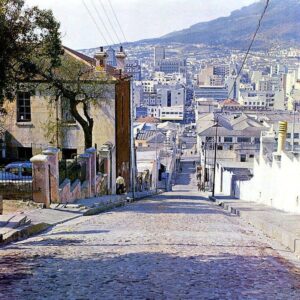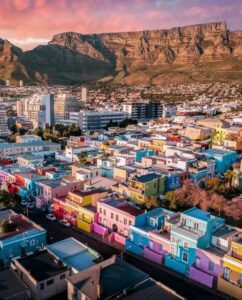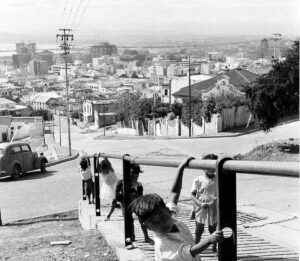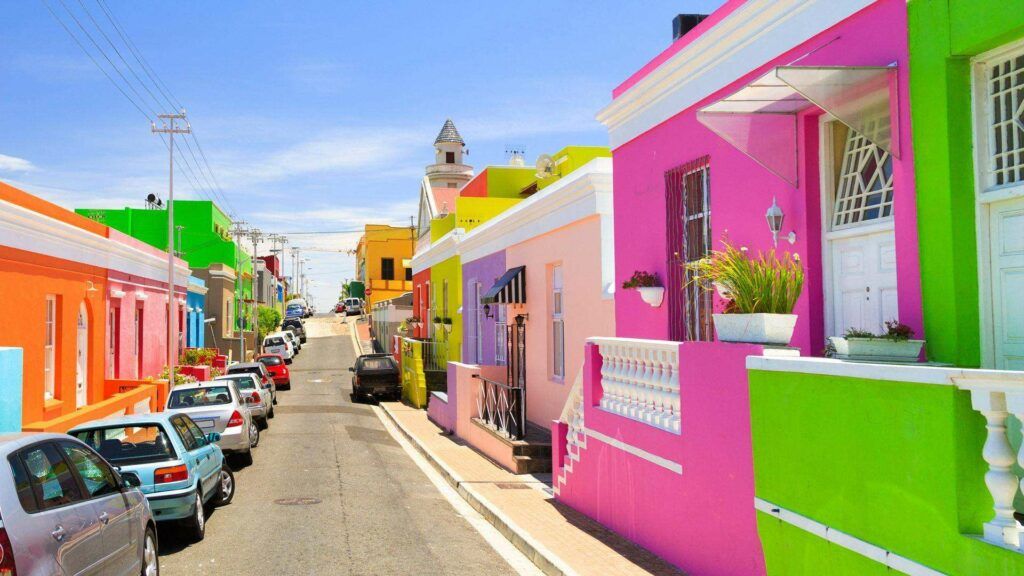History of Bo Kaap
Province: Western Cape
Coordinates: 33°55′15″S 18°24′55″E
Municipality: City of Cape Town
The Bo Kaap is an area on the slopes of Signal Hill. it is also known as “The slave quarter or Malay Quarter. The Bo Kaap has been the traditional home of Cape Town’s Muslim community since the second half of the eighteenth century. The residents of the area are predominantly descendants of slaves brought to the Cape in the sixteenth and seventeenth centuries from the Malay archipelago, Java and Indonesia. The indigenous population of the Cape resisted the Dutch so the colonists decided that slave labour had to be imported.

During 1760 Jan de Waal of the Groote Kerk bought land at the foot of Signal Hill, between Dorp and Wale Streets. A year later he obtained an adjacent parcel, extending his holding to Rose/Chiappini/Shortmarket Streets. Between 1763 and 1768 De Waal built several “huurhuisies” (houses to rent), that he leased to his slaves. The first three are at 71 Wale Street (now the Bokaap Museum), above Buitengracht Street, and 42 Leeuwen Street. After the emancipation of the slaves in 1834, there was an urgent need for modest homes for the freed slaves. These freed slaves were mostly Muslims. They were often fishermen, traders and skilled craftspeople who later became the homeowners of the buildings. They expressed their freedom and new homeowner status by painting the houses that as rented homes were painted white, in the bright colours we see today. Here in the Bo Kaap, small houses were built in the Cape Dutch and Cape Georgian styles.


Since the demise of “the Group Areas Act” the Bo Kaap has become a sought-after area for its interesting buildings and central location. This “gentrification” is sadly threatening this close-knit community.

Tuan Guru, whose Kramat is in the Muslim cemetery in the Bo Kaap, was a Prince from the Trinity Islands. His “crime” is unknown. However, he arrived in the Cape in 1780 as a State prisoner. He was incarcerated for 12 years. When he was released, Tuan Guru became active in the Muslim community around Dorp Street and was instrumental in the first Muslim School to be built in 1793. In 1795 he oversaw the first Mosque being built. Another Auliyah who served a 12-year sentence was Tuan Sayed Alawie who came from Yemen. After his release, he became a policeman so that he would have contact with slaves and could spread the word of Islam. He died in 1803 and was also buried in the Bo Kaap.

Schotsche Kloof
Schotsche Kloof is part of the Malay quarter on the slopes of Signal Hill one of the oldest parts of Cape Town. It was built in the third quarter of the 18th century. The influx of people of Malay origin began in the 1830s and it was also often referred to as the Islamic quarter.
Post WW1 the area deteriorated and it was declared a slum in 1944. A group of prominent people worked to retain and rehabilitate the Malay quarter and in 1966 it was declared a national monument
The postal code for Bo Kaap and Schotsche Kloof is 8001
WEATHER IN BO KAAP and schotsche kloof
all listings in bo kaap
Things to see and do in Bo Kaap and Schotsche Kloof
- The noonday gun, Military road Schotze Kloof
- Bo Kaap walking tour
- Bo Kaap museum
Useful Numbers in Bo Kaap and Schotsche Kloof
- Police: CCT central: 021 467 8078
- Traffic department: Gallows Hill: 021 444 8811
- Fire: central fire station: 021 444 8968
- Water: 0860 103 089
- Electricity: 0860 103 089
- Ambulance: 10177
- Post office; Cape Town central 021464 1707
- Library: Cape Town City Library 021444 0983
- Closest hospital; is Netcare Christiaan Barnard 021441 000
- District Six Community Health Centre 021883 5400
- Schotschekloof community Hall : 021 400 3647
- SPCA: Cape of Good Hope Grassy Park 021 700 4140
- Schools: Saint pauls primary,Schotschekloof 021 424 2830
- Boorhaanol centre
- Schotschekloof primary school 021 424 5859
- Vista high 021 4247430


